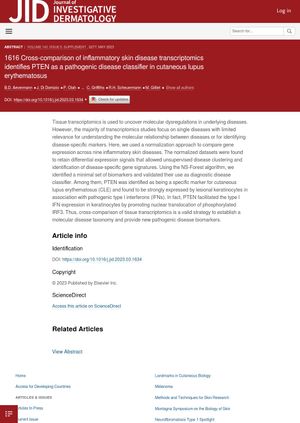Cross-Comparison of Inflammatory Skin Disease Transcriptomics Identifies PTEN as a Pathogenic Disease Classifier in Cutaneous Lupus Erythematosus
April 2023
in “
Journal of Investigative Dermatology
”

TLDR PTEN was identified as a specific marker for the skin disease cutaneous lupus erythematosus, and it helps increase the expression of harmful type I interferons.
The study used tissue transcriptomics to compare gene expression across nine inflammatory skin diseases, aiming to understand the molecular relationship between these diseases and identify disease-specific markers. The normalized datasets retained differential expression signals, enabling unsupervised disease clustering and the identification of disease-specific gene signatures. Using the NS-Forest algorithm, a minimal set of biomarkers was identified and validated for use as diagnostic disease classifiers. Notably, PTEN was identified as a specific marker for cutaneous lupus erythematosus (CLE) and was found to be strongly expressed by lesional keratinocytes in association with pathogenic type I interferons (IFNs). PTEN facilitated the type I IFN expression in keratinocytes by promoting nuclear translocation of phosphorylated IRF3. This suggests that cross-comparison of tissue transcriptomics can establish a molecular disease taxonomy and provide new pathogenic disease biomarkers.



